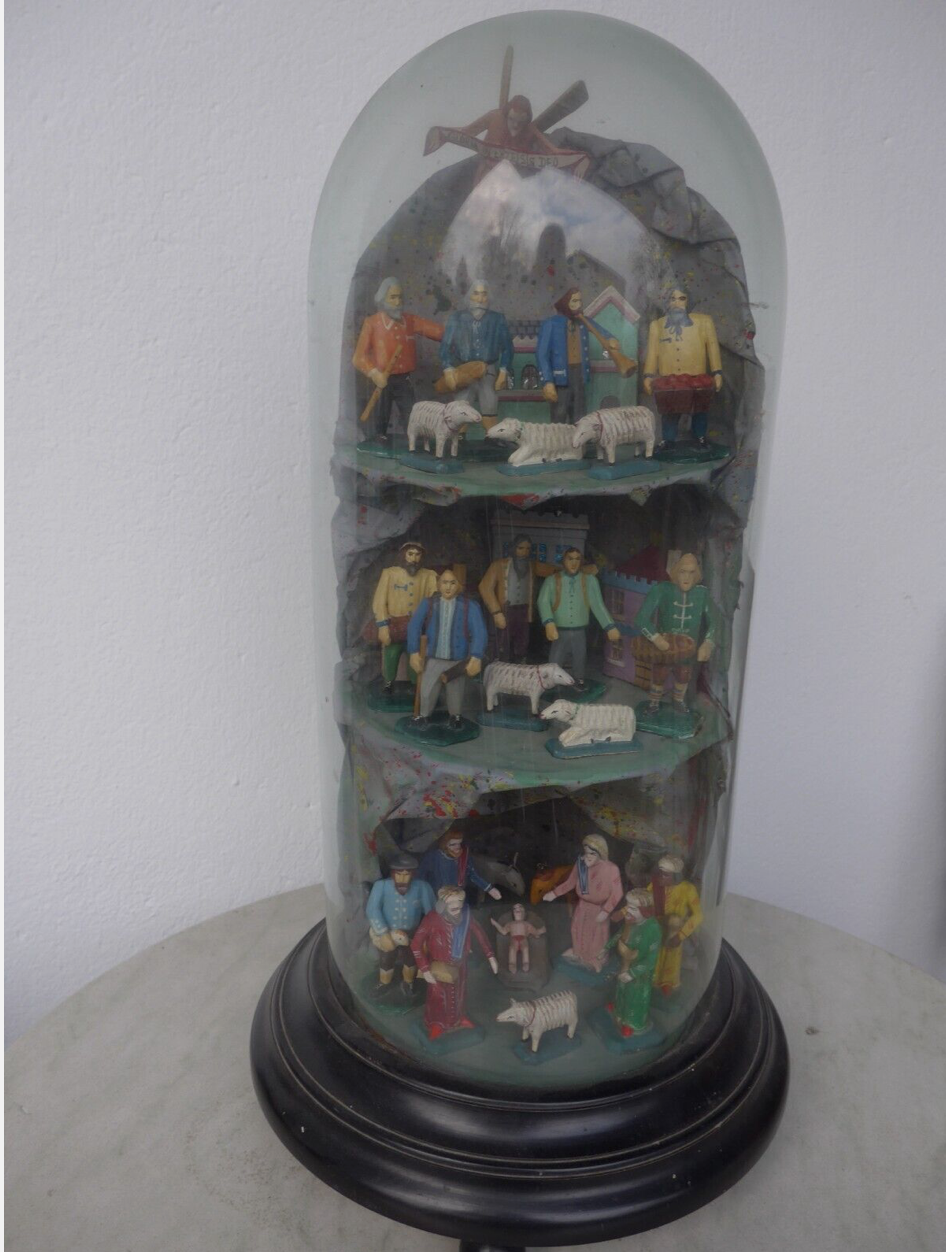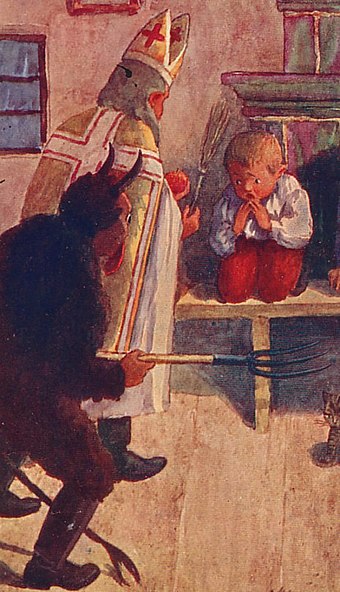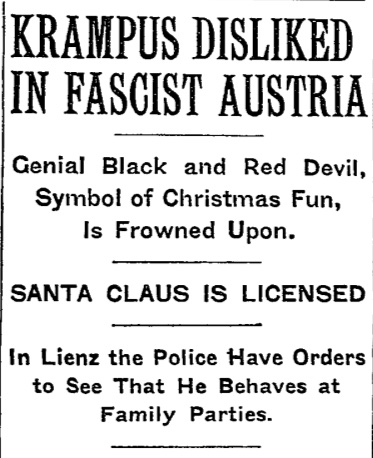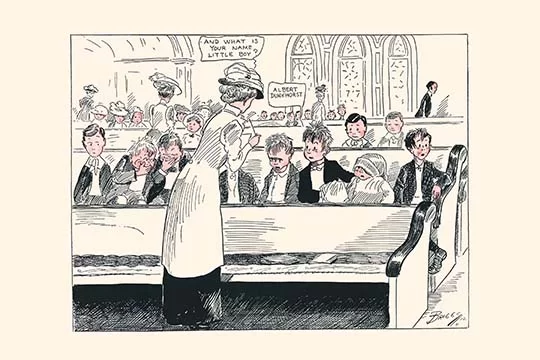In Norway, this sort of three-light candelabra is called a helligetrekongerslys: a Three Kings Candle. On January 6, Epiphany, it is lit and when the candles have burnt down to where the arms meet, the Christmas season has come to an end. The illustration is by the Swedish artist Jenny Nyström who was so influential in creating the image of Scandinavian Christmas elves.
Author: gerryadmin
King Hilary and the Beggarman
A poem for Christmas by A.A. Milne, author of Winnie the Pooh, illustrated by E.H. Shepherd.
KING HILARY AND THE BEGGERMAN
Of Hilary the Great and Good
They tell a tale at Christmas time;
I’ve often thought the story would
Be prettier but just as good
If almost anybody should
Translate it into rime.
So I have done the best I can
For lack of some more learned man.
Good King Hilary
Said to his Chancellor
(Proud Lord Willoughby,
Lord High Chancellor):
“Run to the wicket-gate
Quickly, quickly,
Run to the wicket gate
And see who is knocking.
It may be a rich man,
Sea-borne from Araby,
Bringing me peacocks,
Emeralds and ivory;
It may be a poor man,
Travel-worn and weary,
Bringing me oranges
To put in my stocking.”
Proud Lord Willoughby,
Lord High Chancellor,
Laughed both loud and free:
“I’ve served Your Majesty, man to man,
Since first Your Majesty’s reign began,
And I’ve often walked, but I never, never ran,
Never, never, never,” quoth he.
Haw! Haw! Haw!
Good King Hilary
Said to his Chancellor
(Proud Lord Willoughby,
Lord High Chancellor):
“Walk to the wicket-gate
Quickly, quickly,
Walk to the wicket-gate
And see who is knocking.
It may be a captain,
Hawk-nosed, bearded,
Bringing me gold-dust,
Spices, and sandalwood:
It may be a scullion,
Care-free, whistling,
Bringing me sugar-plums
To put in my stocking.”
Proud Lord Willoughby,
Lord High Chancellor,
Laughed both loud and free:
“I’ve served in the Palace since I was four,
And I’ll serve in the Palace a-many years more,
And I’ve opened a window, but never a door,
Never, never, never,” quoth he.
Good King Hilary
Said to his Chancellor
(Proud Lord Willoughby,
Lord High Chancellor):
“Open the window
Quickly, quickly,
Open the window
And see who is knocking.
It may be a waiting-maid,
Apple-cheeked, dimpled,
Sent by her mistress
To bring me greeting;
It may be children,
Anxious, whispering,
Bringing me cobnuts,
To put in my stocking.”
Proud Lord Willoughby,
Lord High Chancellor,
Laughed both loud and free:
“I’ll serve Your Majesty till I die—
As Lord Chancellor, not as spy
To peep from lattices; no, not I,
Never, never, never,” quoth he.
Good King Hilary
Looked at his Chancellor
(Proud Lord Willoughby,
Lord High Chancellor):
He said no word
To his stiff-set Chancellor,
But ran to the wicket-gate
To see who was knocking.
He found no rich man
Trading from Araby;
He found no captain,
Blue-eyed, weather-tanned;
He found no waiting-maid
Sent by her mistress;
But only a beggarman
With one red stocking.
Good King Hilary
Looked at the beggarman,
And laughed him three times three;
And he turned that beggarman round about:
“Your thews are strong, and your arm is stout;
Come, throw me a Lord High Chancellor out,
And take his place,” quoth he.
Of Hilary the Good and Great
Old wives at Christmas time relate
This tale, which points, at any rate,
Two morals on the way.
The first: “Whatever Fortune brings,
Don’t be afraid of doing things.“
(Especially, of course, for Kings.)
It also seems to say
(But not so wisely): “He who begs
With one red stocking on his legs
Will be, as sure as eggs are eggs,
A Chancellor some day.“
The Christmas Fire
 From an 1826 English book, this admiring praise of a Christmas fire:
From an 1826 English book, this admiring praise of a Christmas fire:
I remember we had a discussion that time, as to what was the great point and crowning glory of Christmas. Many were for mince-pie; some for the beef and plum-pudding; more for the wassail-bowl; a maiden lady timidly said, the misletoe; but we agreed at last, that although all these were prodigious, and some of them exclusively belonging to the season, the fire was the great indispensable. Upon which we all turned our faces towards it, and began warming our already scorched hands. A great blazing fire, too big, is the visible heart and soul of Christmas. You may do without beef and plum-pudding; even the absence of mince-pie may be tolerated; there must be a bowl, poetically speaking, but it need not be absolutely wassail. The bowl may give place to the bottle. But a huge, heaped-up, over heaped-up, all-attracting fire, with a semicircle of faces about it, is not to be denied us. It is the lar and genius of the meeting; the proof positive of the season; the representative of all our warm emotions and bright thoughts; the glorious eye of the room; the inciter to mirth, yet the retainer of order; the amalgamater of the age and sex; the universal relish. Tastes may differ even on a mince-pie; but who gainsays a fire? The absence of other luxuries still leaves you in possession of that; but
‘Who can hold a fire in his hand
With thinking on the frostiest twelfth-cake?’
Let me have a dinner of some sort, no matter what, and then give me my fire, and my friends, the humblest glass of wine, and a few penn’orths of chesnuts, and I will still make out my Christmas.
New Year’s Gifts
Since we must always consider Christmas as a season, and not just December 25, we can understand how a gift given on St Nicholas Day, or St Catherine’s Day, or St Lucy’s Day, New Year’s Eve, or New Year’s Day is a Christmas present.
 Thus the title of the first book to feature a picture of Santa Claus: “The Children’s Friend: A New-Year’s Present to the Little Ones from Five to Twelve.” In this publication Santa Claus arrives on Christmas Eve to deliver gifts.
Thus the title of the first book to feature a picture of Santa Claus: “The Children’s Friend: A New-Year’s Present to the Little Ones from Five to Twelve.” In this publication Santa Claus arrives on Christmas Eve to deliver gifts.
In the sixteenth century, the English humanist Roger Ascham spoke about writing a book that might prove to be “a new-year’s gift that Christmas.” That book turned out to be The Scholemaster, showing a plain and perfect way of teaching the learned languages. In it Ascham criticizes the use of corporal punishment as an aid to educating children. “Beat a child if he dance not well,” he said, “and cherish him though he learn not well, ye shall have him unwilling to go to dance, and glad to go to his book.”
Some Christmas Propaganda
During World War I the British navy imposed a blockade on the German Empire, cutting it off from needed resources and foodstuffs. This cartoon imagines that all Germans have left to enjoy for their Christmas meal is art depicting the food they are deprived of.
Christmas “pantos” are dramatic presentations during the holiday season much enjoyed by British families for over a century. The characters are stereotyped and familiar to the audiences. One of the favourite themes is Jack and the Beanstalk. Here the cartoonist in the midst of World War II portrays Soviet leader Stalin as Joe the Giant Killer with a Nazi soldier tumbling to his doom.
Krampus and the Fascists
The devilish figure of Krampus was a popular image in Austrian Christmases. He accompanied St Nicholas and terrified children into good behaviour. However, in 1934 the fascist government of Austria chose to clamp down on this tradition.
The New York Times December 11, 1934 reported that under pressure from Catholic clergy the Austrian authorities urged a boycott of Krampus, warned against rowdy parties involving the devil, and demanded that anyone wishing to appear as Santa Claus must be licensed. Such warnings do not seem to have had much effect at the time and to this day Austrians are still devoted to Krampus.
Ornaments and the Secret Police
 Since the 1850s, in the Thurinigian town of Lauscha, family businesses had produced the glass ornaments that decorated Christmas trees around the world. These mouth-blown, hand-painted baubles came in thousands of shapes and attracted the interest of the Woolworth’s department store chain which bought millions for their stores in Britain and North America. After the Second World War, Lauscha was located in the communist German Democratic Republic which was suspicious of private enterprise. The ornament-making family businesses became state-run and an object of concern for the Stasi, the East German secret police.
Since the 1850s, in the Thurinigian town of Lauscha, family businesses had produced the glass ornaments that decorated Christmas trees around the world. These mouth-blown, hand-painted baubles came in thousands of shapes and attracted the interest of the Woolworth’s department store chain which bought millions for their stores in Britain and North America. After the Second World War, Lauscha was located in the communist German Democratic Republic which was suspicious of private enterprise. The ornament-making family businesses became state-run and an object of concern for the Stasi, the East German secret police.
Why had the Lauscha Christmas decoration business became a matter of national security? In the first place, because the area was notorious for its acts of low-level resistance and non-cooperation with the communist authorities. The Stasi blamed this on the family and commercial contacts that the local glassblowers had with West Germany. Secondly, it was feared that such contacts might prove harmful to the economy of the GDR, with trade secrets leaked to the ornament-making industry across the border.
The East German government was concerned that Lauscha decorations might be made subject to restrictions on imports to the West which wished to protect its own manufacturers. Stasi agents at the toys fair in Nuremberg also found that Lauscha products were developing a bad reputation for declining quality and unreliable delivery – typical complaints about Soviet bloc goods. The secret police made it their business to collect samples and catalogues from their western competitors.
After the Berlin Wall came down in 1989 and the two Germanys reunited in 1991, the Lauscha glass works ceased to be state-run enterprises and many returned to the ownership of the families traditionally associated with the trade.
Lazy Crèches
 In Králíky, Bohemia, admirers of artisanal nativity scenes will find what are known as Grulich cribs, so-called after the former name of the town.
In Králíky, Bohemia, admirers of artisanal nativity scenes will find what are known as Grulich cribs, so-called after the former name of the town.
These crèches were traditionally made by the area’s miners who were looking to supplement their income. They are often constructed in the form of a mountain or tower. In a typical arrangement, at the top are placed little figures of shepherds or craftsmen bringing gifts to the Holy Family. On a level beneath that are Mary, Joseph, and the Baby Jesus; on the bottom are miners. (This composition is by no means obligatory as can be seen in the image above.)
Because such nativity scenes were assembled and covered with a glass dome, no work was necessary to put them together at Christmas time – hence the nickname “lazy crèches”.
The Grulich style is also known for the appearance of non-traditional figures such as the devil, chimney sweeps and folk in modern dress.
Christmas Bummers Revisited
In an earlier post I wrote about the phrase “Christmas bummers” which could mean (in Australia) a pair of underwear with Santas printed on them; (in contemporary America) a sad Christmas song; or (over a century ago) children who went from church to church to reap the goodies handed out during Christmas pageants.
Here is a cartoon of the early twentieth century showing a row of Christmas bummers, one of whom has brought along a bag for his loot, pretending to be regular members of the congregation.
A 30-Second Christmas Sermon
In the year 441 Kyros Panopolites was in serious trouble. He had once been a renowned poet and a successful civic administrator in the Byzantine Empire. With the patronage of the Empress Theodokia, wife of Theodosius II, he had risen to be the City Prefect and the Praetorian Prefect of the East. Thanks to his efforts Constantinople recovered quickly from the catastrophic earthquake of 437 but in his ascent to the top he had made powerful enemies. The eunuch Chrysaphios, a rival civil servant, had poisoned Kyros’s reputation in the eyes of the emperor, who may already have been jealous of his popularity with the citizens of Constantinople. Theodosius accused Kyros of being a pagan, stripped him his offices, and seized his property.
With no further life for him in the secular world, Kyros turned to the Church and was ordained a priest. On the orders of the emperor he was made a bishop and dispatched to the diocese of Koryaion in Phhrygia. This was by no means a promotion — the inhabitants of Koryaion had a reputation for rowdiness. In fact, they had killed there four previous bishops. No doubt Theodosius wished for them to make Kyros their fifth victim.
On Christmas Day 441, Kyros was conducting the church service when the congregation called on him to preach. They had heard the rumours of his being a pagan and wanted to see for themselves whether their new bishop could prove himself to be a true Christian. Kyros stepped into the pulpit and delivered the following sermon:
Brethren, let the birth of God our Saviour Jesus Christ be honoured with silence, because the Word of God was conceived in the holy Virgin through hearing alone. To him be glory for ever. Amen.
This thirty-second oration was greeted with great enthusiasm instead of a lynching. Kyros went on to become a beloved bishop, noted for his kindness to the poor.










